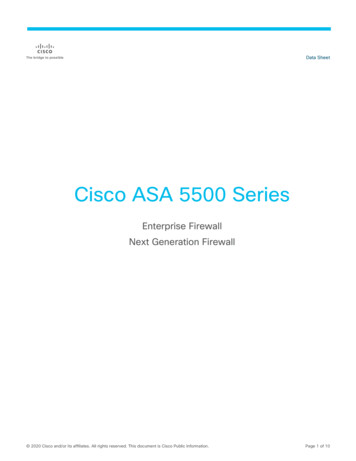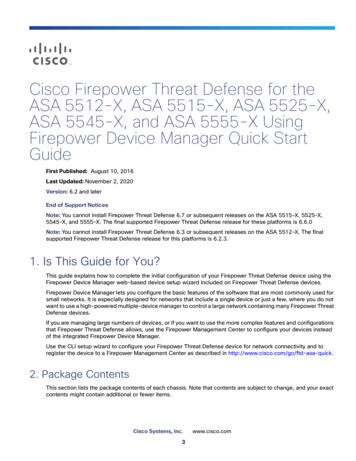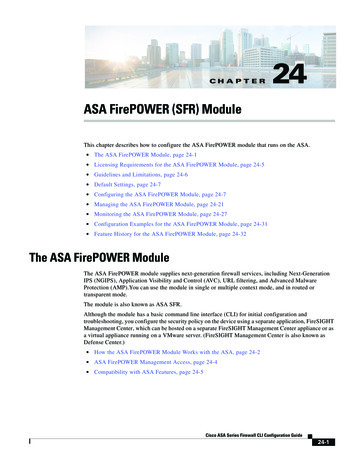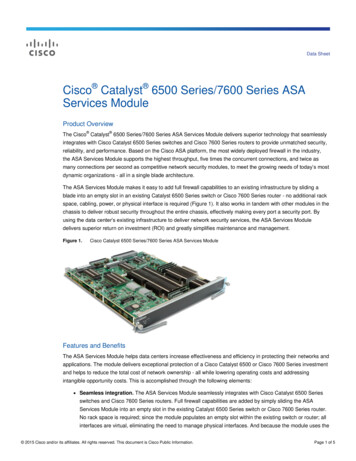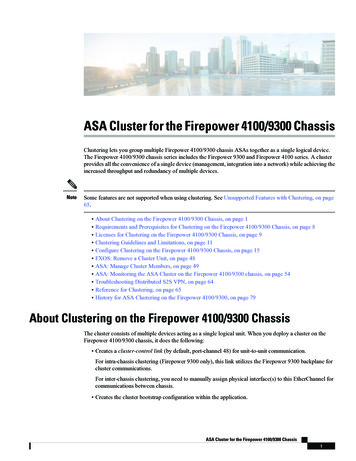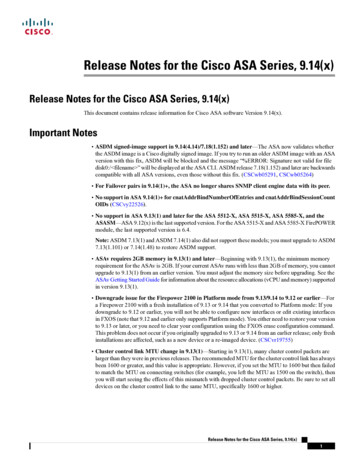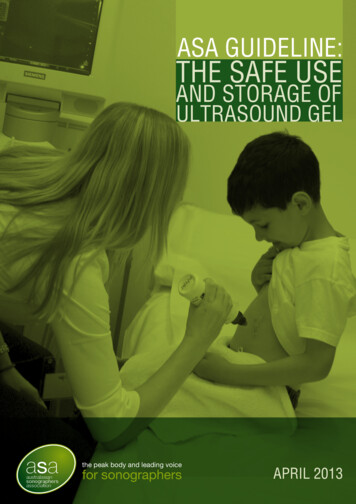
Transcription
ASA GUIDELINE:THE SAFE USEAND STORAGE OFULTRASOUND GELthe peak body and leading voicefor sonographersAPRIL 2013
AUSTRALASIAN SONOGRAPHERS ASSOCIATIONASA GUIDELINE: THE SAFE USE AND STORAGE OF ULTRASOUND GELApproved by Board – April 2013Scheduled review – April 2016For further information, please contact:Australasian Sonographers AssociationLevel 2, 93–95 Queen StreetMelbourne VIC 3000AustraliaP: 61 3 9585 2996E: ceo@sonographers.orgW: www.sonographers.orgContentsii c Goods Administration (TGA) recommendations2ASA recommendations for the safe use and storage of ultrasound gel31. Use of sterile gel32. Use of non-sterile gel33. Use of gel containers and bottles34. Use of gel during patient examination45. Warming of gel46. Storage and discarding of gel4Related ASA Guidelines5Acknowledgements5References5ASA guideline: The use and storage of ultrasound gel April 2013
AUSTRALASIAN SONOGRAPHERS ASSOCIATIONIntroductionThe Australian Sonographers Association (ASA) is dedicated to guiding the advancement of the sonographyprofession to ensure the community has access to quality sonographic services. A key strategic objective of theASA is to promote and advocate for best practice in medical sonography through the development of evidencebased standards and guidelines. The ASA guideline on The safe use and storage of ultrasound gel providessonographers with recommendations on how to minimise the risk of transmitting infection that may occur due tothe use of contaminated ultrasound gel.In the past, contaminated ultrasound gel has been associated with outbreaks of infection in various settings andwith various organisms. Implementing a range of infection prevention and hygiene practices in the safe use andstorage of ultrasound gel can minimise the risk of microbial growth of microorganisms in gel, and as such, thepotential subsequent infection of patients. For more information on how and why the recommendations includedin this guideline were developed, refer to the ASA Background Paper: The safe use and storage of ultrasound gel.The ASA recommends that this guideline be used as a basic foundation for workplace protocols to be developedupon, as well as a guide for individual sonographers in the absence of workplace protocols. It is intended toprovide useful tips and best practice recommendations, not rigid standards, on how to minimise the risk oftransmitting infection in all sonography departments and sites in which ultrasound gel is used on patients. Whilethis guideline is primarily intended to be used by sonographers, it may also be a useful resource for other medicalprofessions which use ultrasound gel in their dealings with patients.In the first instance, sonographers should follow their workplace protocols. The level of risk and practicality ofimplementation associated with each recommendation in this guideline should inform any decisions on howthis guideline is adapted to suit the individual circumstances of each workplace. The guideline should be used inconjunction with workplace risk assessments, cost assessments, environmental considerations and other relevantindustry standards.The ASA Background Paper: The safe use and storage of ultrasound gel can be found on the ASA website at:http://www.a-s-a.com.au/cms/?c 136&t asa-guidelines.DISCLAIMERThis document aims to provide recommendations based on the best evidence available to the ASA at thetime of publication to assist sonographers in their decision-making and development of workplace protocols.Recommendations made are not enforceable standards. The ASA gives no warranty that the information in thisdocument and any online updates on the ASA website are correct or complete. This document is necessarilygeneral so as to be applicable to the whole profession. It is not intended to be a substitute for a healthcareprofessional’s judgement in each case. The ASA shall not be liable for any loss whatsoever whether due tonegligence or otherwise arising from the use of or reliance on this document.ASA guideline: The use and storage of ultrasound gel April 2013 1
AUSTRALASIAN SONOGRAPHERS ASSOCIATIONThe recommendations made in this guideline are intended to be best practice recommendations, notrigid standards, to be appropriately adapted to suit the individual circumstances and level of risk in eachworkplace. The ASA advises in the first instance: always follow the manufacturer’s instructions for use.AimThe aim of this guideline is to assist sonographers in minimising the potential risk of transmitting infectiondue to the use of contaminated ultrasound gel. This guideline provides best practice recommendations for thesafe use and storage of ultrasound gel. The recommendations made are necessarily general to be applicable tothe profession as a whole, and should be adapted by sonographers so as to be appropriately applicable to theindividual circumstances of their workplace. This guideline should be used in conjunction with workplace riskassessments, cost assessments, environmental considerations and other relevant industry standards.BackgroundFor further information on how and why the recommendations in this guideline were developed, refer to theASA Background Paper: The safe use and storage of ultrasound gel found on the ASA website at:http://www.a-s-a.com.au/cms/?c 136&t asa-guidelines.DefinitionsFor the purpose of this guideline, the following definitions apply: Dispensing container: used to store ultrasound gel not currently in use (bulk) Reusable bottle: used to store ultrasound gel for current use on patient; bottle is refillable onceemptied Pre-filled disposable bottle: used to store ultrasound gel for current use on patient; bottle is notrefillable and is discarded once emptied. It is purchased pre-filled Single-use bottle or sachet: used for sterile or non-sterile gel. Bottle or sachet is discarded after singleexamination is completed, not reusable.Therapeutic Goods Administration (TGA) recommendationsThe TGA has written the following recommendations for health professionals to follow in their use and storage ofultrasound gel: Ensure reusable dispenser bottles are completely emptied, thoroughly washed and dried daily/weeklyaccording to your facility’s infection control practices Clean all reusable equipment according to the manufacturer’s instructions Do not reuse single-use equipment For procedures that require the use of sterile gel, ensure that only unopened containers/sachetslabelled ‘sterile’ are used.The ASA suggests these TGA recommendations be adopted as the basic minimum standard for sonographydepartments in minimising the possible risk of transmitting infection due to the use of contaminatedultrasound gel.2 ASA guideline: The use and storage of ultrasound gel April 2013
AUSTRALASIAN SONOGRAPHERS ASSOCIATIONASA recommendations for the safe use and storage ofultrasound gelThe ASA recommendations represent best practice standards, intended to be appropriately adapted to suitindividual workplace circumstances.1. Use of sterile gel1.1Sterile gel is to be used for all critical procedures, such as invasive examinations that pass adevice through tissue, and for all procedures that may involve contact with non-intact skin or openwounds. A sterile probe cover should also be used.1.2It is highly recommended that sterile gel be used for all semi-critical procedures, such asexaminations that may involve contact with mucous membranes (e.g. transrectal or transvaginalexaminations).1.3Sterile gel should be used for examinations that involve critically ill hospitalised neonates, patientswith known immunodeficiencies and patients on known immunosuppressive therapy, as they maybe more susceptible to infection.1.4Sterile gel can only be single-use, as once a sterile gel package has been opened it is no longersterile and therefore cannot be reused.2. Use of non-sterile gel2.1The use of non-sterile gel should be limited to low-risk general examinations on intact skin.2.2If a non-sterile gel is being used on a patient who is on any transmission-based precautions, asingle-use bottle or sachet should be used. If the patient is an inpatient, a reusable bottle can beleft in the room if repeat procedures are necessary and discarded when isolation of the patient isdiscontinued. The bottle should not be left in the room for an extended period of time without theuser being present.3. Use of gel containers and bottles3.1For non-sterile gel, the use of pre-filled disposable bottles to store and dispense ultrasound gel isrecommended, to be discarded once emptied.3.2Reusable dispensing containers and bottles may only be used for non-sterile gel.3.3When first using a new gel bottle or a newly refilled bottle, the bottle should be dated and it isrecommended that unused gel be discarded after one month.3.4When filling a reusable bottle, ensure the expiry date on the bulk container the ultrasound gel wasoriginally packaged in has not expired (refer also to 6.1).3.5When filling a reusable bottle, do not touch the opening of either dispensing container or bottlewith your bare hands.3.6Reusable bottles should be filled using a dispensing device, such as a pump.3.7Bottles should not be ‘topped up’ (refilled when only partially empty).3.8Once emptied, reusable dispensing containers or bottles should be washed in warm soapy water oran appropriate disinfectant, rinsed thoroughly and dried prior to refilling.3.9Discard all dispensing containers or bottles that have cracks or other similar defects. Inspectregularly. Only completely intact dispensing containers and bottles may be reused.ASA guideline: The use and storage of ultrasound gel April 2013 3
AUSTRALASIAN SONOGRAPHERS ASSOCIATION4. Use of gel during patient examination4.1Ensure there is an adequate amount of gel in the bottle for the duration of the examination prior tocommencing. Bottles should not be refilled part way through an examination.4.2Reusable bottles should be refilled as close as possible to the time of use.4.3Standard hand hygiene precautions should be adhered to when using gel products. Refer to theASA Infection Prevention and Control Guidelines for Sonographers: An adapted summary of theAustralian Guidelines for the Prevention and Control of Infection in Healthcare, p. 5.4.4Dispensing containers used to store gel in bulk should not be used to directly distribute gel on totransducers or patients.4.5Nozzles of bottles should not come in direct contact with a patient, staff or instrumentation.4.6If the nozzle of the gel bottle comes in direct contact with a patient’s skin/tissue, it should be wipedwith an appropriate disinfectant wipe.4.7After every examination, all gel must be removed from the probe and the probe cleaned with anappropriate and compatible disinfectant.4.8It is recommended that the outside of the gel bottle be wiped with an appropriate disinfectantbetween patients.4.9For sites that use gel infrequently, single-use bottles or sachets should be used.5. Warming of gel5.1The use of dry heat should be the preferred method for warming gel.5.2If the device used to warm gel utilises water, bottles should be removed from the warmer as soonas possible and dried immediately.5.3Warming devices that require manual cleaning should be cleaned regularly as per themanufacturer’s instructions, with warm soapy water or an appropriate disinfectant. It isrecommended that stand-alone warming devices be cleaned weekly.5.4If the warming device becomes soiled, clean immediately.6. Storage and discarding of gel4 6.1Gel products should be appropriately labelled with contents, date of opening, and date of expiry.6.2Gel products should be stored in areas that are dry and protected from potential sources of contamination, such as dust, moisture, insects, rodents, etc.6.3If evidence of contamination is present or package integrity has been breached, the gel productshould be discarded immediately.6.4Gel products should be rotated when restocking takes place.6.5Gel holders should be regularly inspected and cleaned with warm soapy water or an appropriatedisinfectant.6.6Strict attention should be paid to expiration dates and any gel that has passed this date should beimmediately discarded.ASA guideline: The use and storage of ultrasound gel April 2013
AUSTRALASIAN SONOGRAPHERS ASSOCIATIONRelated ASA GuidelinesASA Background Paper: The safe use and storage of ultrasound gel (2013).ASA Guideline on the Disinfection of Intracavity Ultrasound Transducers (2012).ASA Infection Prevention and Control Guidelines for Sonographers: An adapted summary of the AustralianGuidelines for the Prevention and Control of Infection in Healthcare (2012).These guidelines can be found on the ASA website at: http://www.a-s-a.com.au/cms/?c 136&t asa-guidelines.AcknowledgementsThe ASA would like to acknowledge the Australasian College for Infection Prevention and Control, members of theSonographer Advancement Working Party, and other reputable sonographers for their constructive direction andfeedback throughout the development of this document.ReferencesFor further information on the summary of evidence and references used in the development of this guideline,please refer to the ASA Background Paper: The safe use and storage of ultrasound gel.Available at: http://www.a-s-a.com.au/cms/?c 136&t asa-guidelines.ASA guideline: The use and storage of ultrasound gel April 2013 5
Level 2, 93–95 Queen StreetMelbourneVictoria 3000, AustraliaT: 61 3 9585 2996E: ceo@a-s-a.com.auw: www.sonographers.org
2 ASA guideline: The use and storage of ultrasound gel April 2013 The recommendations made in this guideline are intended to be best practice recommendations, not rigid standards, to be appropriately adapted to suit the individual circumstances and level of risk in each



